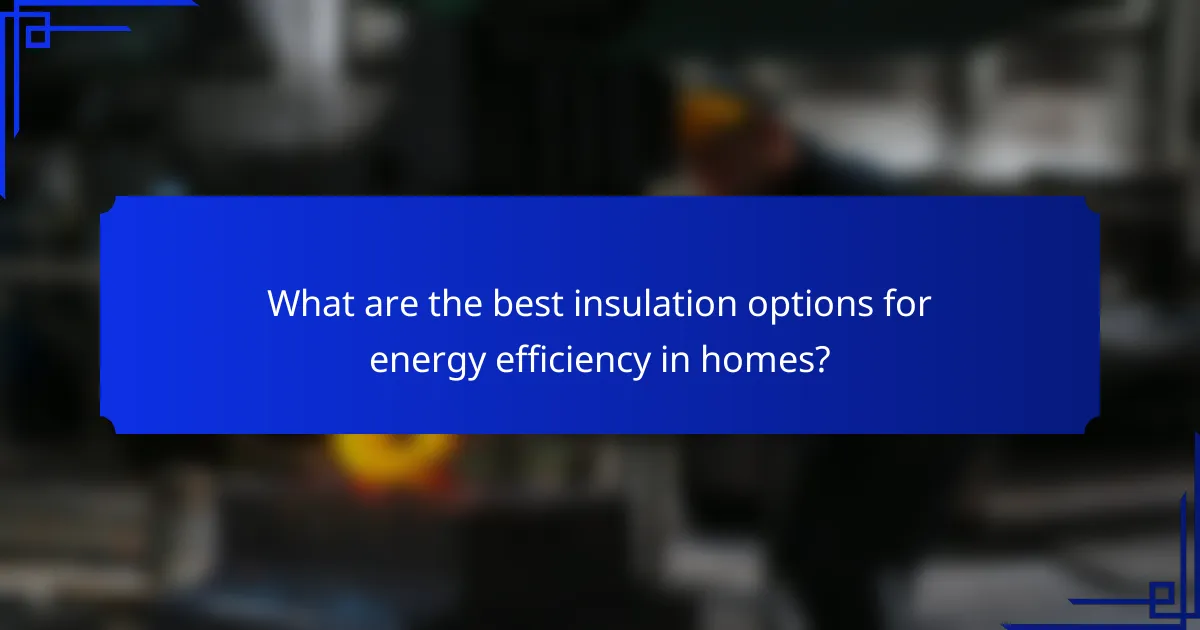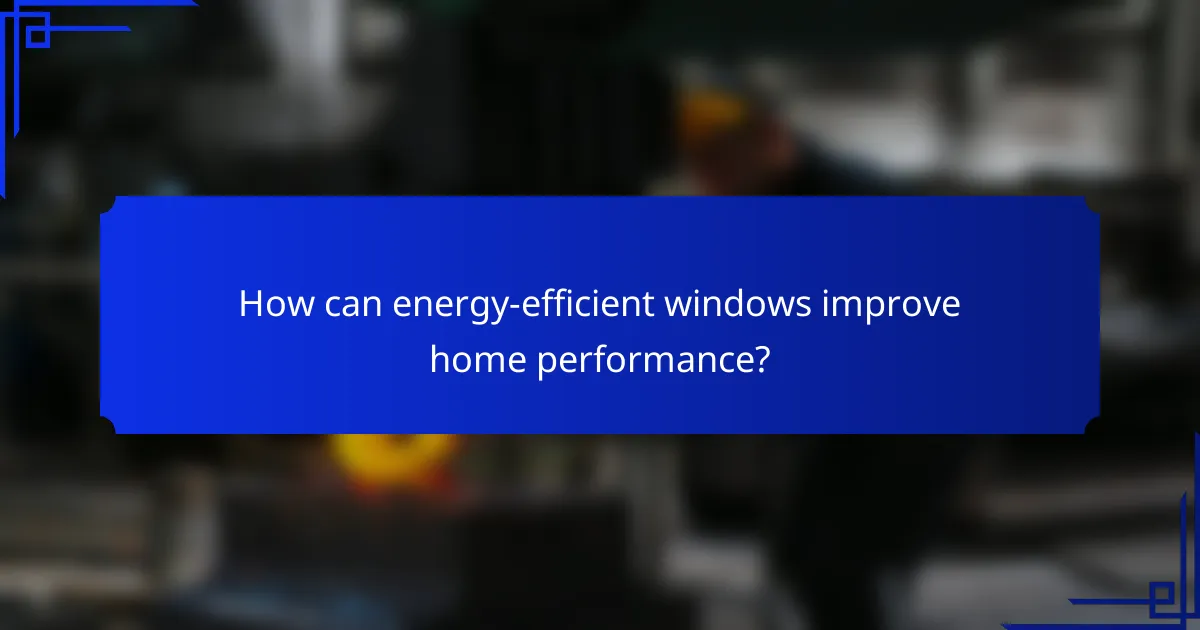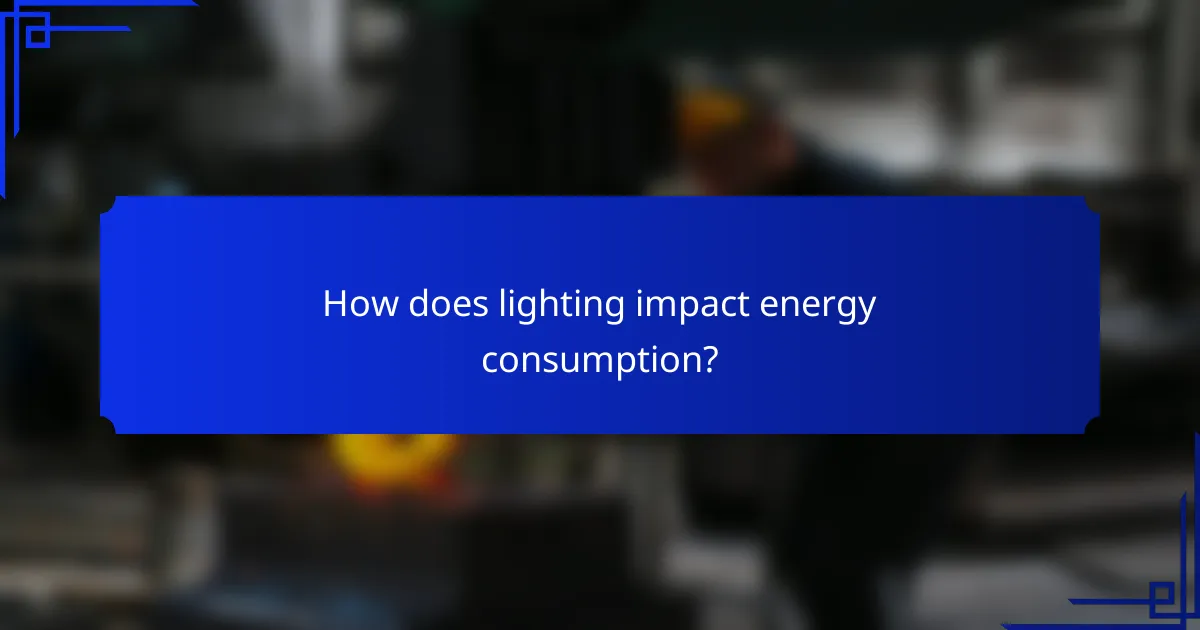Improving energy efficiency in homes involves a combination of effective insulation, high-performance windows, energy-efficient appliances, and advanced HVAC systems. By selecting the right materials and technologies, homeowners can significantly reduce energy consumption, lower utility bills, and enhance overall comfort. Investing in these areas not only benefits the environment but also contributes to long-term savings and improved living conditions.

What are the best insulation options for energy efficiency in homes?
The best insulation options for energy efficiency in homes include fiberglass, spray foam, cellulose, mineral wool, and reflective insulation. Each type has unique properties that affect thermal performance, installation methods, and cost, allowing homeowners to choose based on their specific needs and budget.
Fiberglass insulation
Fiberglass insulation is one of the most common types used in residential buildings. It consists of tiny glass fibers and is available in batts, rolls, or loose-fill forms, making it versatile for various applications. It typically has an R-value ranging from 2.9 to 4.3 per inch, which measures its thermal resistance.
When installing fiberglass, ensure proper sealing to prevent air leaks, as this can significantly reduce its effectiveness. It’s also important to wear protective gear during installation to avoid skin irritation from the fibers.
Spray foam insulation
Spray foam insulation is a highly effective option that expands upon application, filling gaps and cracks to create an airtight seal. It offers a high R-value, often between 6 and 7 per inch, making it suitable for attics, walls, and crawl spaces. This type of insulation also provides soundproofing benefits.
While spray foam can be more expensive than other options, its superior air sealing can lead to lower energy bills over time. Professional installation is recommended to ensure proper application and safety, as it involves chemicals that require careful handling.
Cellulose insulation
Cellulose insulation is made from recycled paper products treated for fire resistance. It is typically installed as loose-fill and has an R-value of about 3.2 to 3.8 per inch. This eco-friendly option is effective in reducing air leaks and can be blown into walls and attics.
When considering cellulose, check for proper installation to avoid settling, which can reduce its effectiveness. It is also important to ensure that the material is treated to resist pests and moisture.
Mineral wool insulation
Mineral wool insulation, also known as rock wool, is made from natural or recycled materials and is fire-resistant. It has an R-value of approximately 3.0 to 3.3 per inch and provides excellent soundproofing qualities. This type is suitable for high-temperature areas, such as around chimneys.
Mineral wool is easy to handle and install, but it can be more expensive than fiberglass. Ensure that it is installed in a way that maintains its density and prevents air gaps for optimal performance.
Reflective insulation
Reflective insulation, often made from aluminum foil, works by reflecting radiant heat away from living spaces. It is particularly effective in hot climates where cooling costs are a concern. This type of insulation is typically installed in attics and can be combined with other insulation types for enhanced performance.
When using reflective insulation, ensure it is installed with an air gap to maximize its effectiveness. It is most beneficial when used in conjunction with other insulation methods to create a comprehensive thermal barrier.

How can energy-efficient windows improve home performance?
Energy-efficient windows enhance home performance by reducing heat loss in winter and minimizing heat gain in summer, leading to lower energy bills and increased comfort. They help maintain a stable indoor temperature, which can significantly improve overall energy efficiency in a home.
Double-glazed windows
Double-glazed windows consist of two panes of glass separated by a space filled with air or gas, which acts as an insulator. This design reduces heat transfer, making homes more energy-efficient. Homeowners can expect a reduction in energy costs by around 10-20% when switching to double-glazed windows.
When considering double-glazed windows, check for the space between the panes and the type of gas used, as these factors can influence insulation performance. Look for options with a low U-value, which indicates better insulation properties.
Low-E glass windows
Low-E (low emissivity) glass windows have a special coating that reflects heat while allowing light to enter. This technology helps keep homes cooler in summer and warmer in winter, further enhancing energy efficiency. Low-E windows can improve energy savings by approximately 20-30% compared to standard glass.
When selecting Low-E glass, consider the climate in your area. Different coatings are optimized for various climates, so choose a product that suits your local weather conditions for maximum benefit.
Energy Star-rated windows
Energy Star-rated windows meet strict energy efficiency guidelines set by the U.S. Environmental Protection Agency. These windows are tested for performance and can significantly reduce heating and cooling costs. Homeowners can save 10-15% on energy bills by installing Energy Star-rated windows.
To ensure you are purchasing genuine Energy Star-rated windows, look for the Energy Star label and check the NFRC (National Fenestration Rating Council) ratings. This will help you compare performance across different brands and models.
Window films
Window films are thin layers applied to existing windows that can enhance energy efficiency by reducing solar heat gain and glare. They can be a cost-effective alternative to replacing windows, providing energy savings of around 5-10% depending on the type of film used.
When choosing window films, consider factors such as UV protection, visible light transmission, and the film’s durability. Professional installation is often recommended to ensure optimal performance and longevity of the film.

What appliances enhance energy efficiency?
Energy-efficient appliances significantly reduce energy consumption, leading to lower utility bills and a smaller environmental footprint. Key appliances include Energy Star-rated refrigerators, high-efficiency washing machines, smart thermostats, and induction cooktops, each designed to maximize efficiency and performance.
Energy Star-rated refrigerators
Energy Star-rated refrigerators use about 15% less energy than standard models, making them a smart choice for energy efficiency. These refrigerators are designed with advanced insulation and energy-saving features such as LED lighting and efficient compressors.
When shopping for a refrigerator, look for the Energy Star label, which indicates compliance with strict energy efficiency guidelines set by the U.S. Environmental Protection Agency. Consider models with adjustable shelves and temperature controls to optimize energy use based on your needs.
High-efficiency washing machines
High-efficiency washing machines consume significantly less water and energy compared to traditional models, often using up to 50% less water per load. These machines typically feature front-loading designs that allow for larger loads and better cleaning performance.
To maximize energy savings, choose a washing machine with a high Energy Factor (EF) rating. Look for features such as load sensing and multiple wash cycle options to ensure you are using the right settings for each load, which can further enhance efficiency.
Smart thermostats
Smart thermostats can reduce heating and cooling costs by up to 10-15% by optimizing temperature settings based on your schedule and preferences. These devices learn your habits and adjust the temperature automatically, ensuring comfort while minimizing energy waste.
When selecting a smart thermostat, consider compatibility with your HVAC system and features like remote access via smartphone apps. Look for models that provide energy usage reports, helping you track and adjust your consumption over time.
Induction cooktops
Induction cooktops are more energy-efficient than traditional gas or electric stoves, using about 90% of the energy generated for cooking, compared to around 70% for conventional electric cooktops. They heat pots and pans directly through electromagnetic energy, leading to faster cooking times and less wasted heat.
When choosing an induction cooktop, ensure your cookware is compatible, as it must be ferrous (magnetic). Consider features like multiple cooking zones and precise temperature control to enhance your cooking experience while saving energy.

How does lighting impact energy consumption?
Lighting significantly affects energy consumption, accounting for a notable portion of residential and commercial electricity use. By choosing energy-efficient lighting options, you can reduce your overall energy bills and environmental impact.
LED lighting
LED (Light Emitting Diode) lighting is one of the most energy-efficient options available, using up to 80% less energy than traditional incandescent bulbs. They have a longer lifespan, often lasting 15,000 to 50,000 hours, which means fewer replacements and less waste.
When considering LED lighting, look for products that are ENERGY STAR certified to ensure maximum efficiency and quality. While the initial cost may be higher than other types, the long-term savings on energy bills make them a wise investment.
CFL bulbs
CFL (Compact Fluorescent Lamp) bulbs are another energy-efficient choice, using about 70% less energy than incandescent bulbs and lasting around 7,000 to 15,000 hours. They emit less heat, which can help reduce cooling costs in warmer months.
However, CFLs contain a small amount of mercury, so proper disposal is essential. They may take a moment to reach full brightness, which can be a drawback in certain situations.
Smart lighting systems
Smart lighting systems allow for greater control over energy consumption by enabling users to schedule, dim, and remotely manage their lights. These systems can integrate with home automation setups, enhancing convenience and energy efficiency.
Investing in smart bulbs or smart switches can lead to significant savings, especially when combined with motion sensors or timers. Be mindful of compatibility with existing fixtures and consider the initial setup costs versus long-term energy savings.
